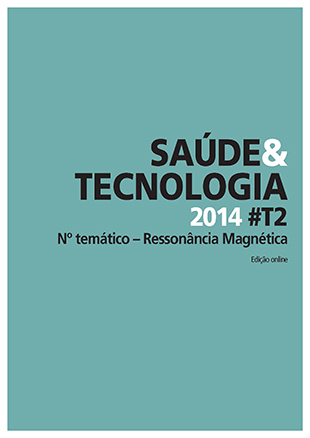Mapping the motor cortex with BOLD functional magnetic resonance imaging
DOI:
https://doi.org/10.25758/set.1034Keywords:
BOLD, Motor cortex, Functional magnetic resonance imaging (fRMI), Echo time (TE)Abstract
Introduction – Functional magnetic resonance imaging (fMRI) is currently an essential tool for the study of human brain function, both in healthy volunteers and in patients suffering from multiple types of pathology. fMRI is a complex technique that needs to be applied in a careful and rigorous manner, requiring an understanding of its biophysical mechanisms so that reliable results with clinical acceptance can be obtained. The BOLD effect (Blood Oxygenation Level Dependent) is based on the magnetic properties of haemoglobin and it is the most used approach for measuring brain activity using MRI. Goals – To optimise a BOLD fMRI protocol on healthy volunteers for mapping the motor cortex, so that it can be applied to patients in the clinic. Methods – 34 healthy volunteers were divided into 2 study groups: BOLD 1 and BOLD 2. To optimise the acquisition, different paradigms were tested on sub-group BOLD 1. The influence of the echo time (TE) was studied on sub-group BOLD 2. The volume and activation level of the activated regions were compared under different sets of conditions. Results/Discussion – It was possible to identify the motor cortex in all studied individuals. No significant statistical differences were detected when comparing the results obtained with the different acquisition parameters. Conclusion – The protocol was optimised taking into account the level of comfort reported by the volunteers. Given that the goal is to use this protocol to study patients, comfort is a particularly important factor.
Downloads
References
Roy SC, Sherrington CS. On the regulation of blood supply of the brain. J Physiol. 1890;1:85-108.
Ogawa S, Lee TM, Kay AR, Tank DW. Brain magnetic resonance imaging with contrast dependent on blood oxygenation. Proc Natl Acad Sci U S A. 1990;87(24):9868-72.
Buxton RB, Frank LR, Wong EC, Siewert B, Warach S, Edelman RR. A general kinetic model for quantitative perfusion imaging with arterial spin labelling. Magn Reson Med. 1998;40(3):383-96.
Kim MJ, Holodny AI, Hou BL, Peck KK, Moskowitz CS, Bogomolny DL, et al. The effect of prior surgery on blood oxygen level-dependent MR imaging in the preoperative assessment of brain tumors. AJNR Am J Neuroradiol. 2005;26(8):1980-5.
Vlieger EJ, Majoie CB, Leenstra S, Den Heeten GJ. Functional magnetic resonance imaging for neurosurgical planning in neurooncology. Eur Radiol. 2004;14(7):1143-53.
Stippich C, editor. Clinical functional MRI: presurgical functional neuroimaging. New York: Springer; 2007. ISBN 9783642140051
Huettel SA, Song AW, MaCarthy G. Functional magnetic resonance imaging. Sunderland: Sinauer Associates; 2004. ISBN 9780878932887
Jezzard P, Matthews PM, Smith SM. Functional MRI: an introduction to methods. Oxford University Press; 2002. ISBN 9780198527732
Kopietz R, Albrecht J, Linn J, Pollatos O, Anzinger A, Wesemann T, et al. Echo time dependence of BOLD fMRI studies of the piriform cortex. Klin Neuroradiol. 2009;19(4):275-82.
Luo Q, Gao JH. Modeling magnitude and phase neuronal current MRI signal dependence on echo time. Magn Reson Med. 2010;64(6):1832-7.
Fera F, Yongbi MN, van Gelderen P, Frank JA, Mattay VS, Duyn JH. EPI-BOLD fMRI of human motor cortex at 1.5 T and 3.0 T: sensitivity dependence on echo time and acquisition bandwidth. J Magn Reson Imaging. 2004;19(1):19-26.
Mazziotta J, Toga A, Evans A, Fox P, Lancaster J, Zilles K, et al. A probabilistic atlas and reference system for the human brain: International Consortium for Brain Mapping (ICBM). Phil Trans R Soc Lond B Biol Sci. 3001;356(1412):1293-322.
Jenkinson M, Beckmann CF, Behrens TE, Woolrich MW, Smith SM. FSL. Neuroimage. 2012;62(2):782-90.
Afonso A, Nunes C. Estatística e probabilidades: aplicações e soluções em SPSS. Lisboa: Escolar Editora; 2010. ISBN 9789725922996
Gorno-Tempini ML, Hutton C, Josephs O, Deichmann R, Price C, Turner R. Echo time dependence of BOLD contrast and susceptibility artifacts. Neuroimage. 2002;15(1):136-42.
Gupta A, Shah A, Young RJ, Holodny AI. Imaging of brain tumors: functional magnetic resonance imaging and diffusion tensor imaging. Neuroimaging Clin N Am. 2010;20(3):379-400.
Salek-Haddadi A, Friston KJ, Lemieux L, Fish DR. Studying spontaneous EEG activity with fMRI. Brain Res Rev. 2003;43(1):110-33.
Downloads
Published
Issue
Section
License
Copyright (c) 2022 Saúde e Tecnologia

This work is licensed under a Creative Commons Attribution-NonCommercial-NoDerivatives 4.0 International License.
The journal Saúde & Tecnologia offers immediate free access to its content, following the principle that making scientific knowledge available to the public free of charge provides greater worldwide democratization of knowledge.
The journal Saúde & Tecnologia does not charge authors any submission or article processing charges (APC).
All content is licensed under a Creative Commons CC-BY-NC-ND license. Authors have the right to: reproduce their work in physical or digital form for personal, professional, or teaching use, but not for commercial use (including the sale of the right to access the article); deposit on their website, that of their institution or in a repository an exact copy in electronic format of the article published by Saúde & Tecnologia, provided that reference is made to its publication in Saúde & Tecnologia and its content (including symbols identifying the journal) is not altered; publish in a book of which they are authors or editors the total or partial content of the manuscript, provided that reference is made to its publication in Saúde & Tecnologia.







